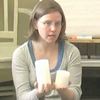What does it mean to take up space?
3. Make meaning
Purpose of the discussion
The purpose of this discussion is to consolidate students’ learning about what it means to take up space and to introduce the term “volume.”
Have students bring their investigation materials (the centimeter cube, the copper and pine cubes, and the 100g plastic modeling clay cube) to the discussion. Ask if any one group disagreed about how to order the cubes and plastic modeling clay. If yes, have that group to put their set of cubes in order. What does the rest of the class think? Resolve any other uncertainties in the same way.
Engage students in the focus question
Who can combine their line of 4 cubes with the order line we made earlier (with the Styrofoam, candle, and wooden block) so that there’s a single line of objects ordered by the amount of space each of the objects takes up?
Take volunteers but have the whole class consult on the exercise, stopping only when you have consensus. Leave this merged order line set up in the classroom for later reference.
Ask different students to share their ‘three fruits’ orders with the rest of the group. If there’s time, have students say where some of the fruits might go in the class order line.
Finally, return to the investigation question: What does it mean to take up space? Are students learning to see the three–dimensional space that an object occupies, and to compare the magnitudes of these spaces across a set of objects? Do they understand how it is different from height and length and weight? Do they think they’ll be able to add new objects to this new order line?
Let students know that the amount of space an object takes up is called volume. Explain that “volume” can also mean an “amount of sound,” like “Turn up the volume on the TV,” but for this unit the class will be using “volume” to mean “amount of space.”
Leave students with these questions to think about:
- How can we describe the amount of space an object takes up?
- How in the world can we measure volume?





